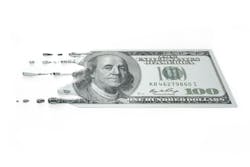There are a number of potential sources of waste in the paint department. Eliminating those can save you time and money, and can be improved through some simple steps. Ted Williams, a manager of business consulting services at Sherwin-Williams, discusses how to get started.
When you have waste in a paint department, it’s going in three places: It’s either being wasted on the vehicle, you’re having to redo the vehicle, or it’s going out the back door. Waste on the vehicle and waste in the trash can are usually where waste happens.
The key thing you have to do to begin with is identify the source of the waste. One of the first things you can do is start tracking the number of redos that go on inside a shop. What I mean by that is a vehicle that needs to be touched twice. I start tracking the redos through either a paint-mixing system or a manual redo tracking form. Any time a redo occurs, the painter must designate that it’s a redo and enter a description of what caused the redo.
If you are able to track your KPIs for your paint department and compare your material cost as a percentage of sales and your materials margins to industry benchmarks, you can also easily identify waste.
Once we identify those sources of waste, we can put an action plan in place to address it.
From the redo standpoint, a lot of the redos are typically tied to the mishandling of parts. Parts get dented or scratched somewhere in the process because they’re not being handled correctly after being refinished. I’m also seeing it a lot where parts were not verified before they were painted. In other words, someone ordered a part, they didn’t take it out of the box to make sure it was the right part for the car, it went to the painter, and, when they put it back on the car, they realized it was the wrong one.
The other one tends to be not doing correct color verification on a color before they painted the car; they either guessed on the color, didn’t do a spray out, or they didn’t verify it with a chip to make sure it was correct, and they painted it the wrong color.
There are a number of simple steps that you can take to reduce waste in the paint department:
- Regarding incorrect color verification, I push people to verify the color as soon as the car comes in the shop. The sooner you can verify the color in the process, the better off you are. Typically I see painters having test day anxiety. What happens is you push that color verification process to the point where the painter is doing it when the car is sitting in the booth and he’s got a production manager screaming at him that the car has to be done. That tends to force him to make a poor decision. If you move it up to earlier in the week when the car first comes in the shop, they’re able to take the appropriate time without the pressure.
- A good mirror-matching process is very important in verifying the correct part. It needs to be mirror-matched against the old part to ensure it’s actually the correct part. That might be utilization of parts carts so you can actually find the old parts. The benefit is that a parts cart allows you to easily organize parts so everyone has access to parts from the vehicle.
- Finally, put a process in place where parts are handled infrequently to reduce scratches and dents. What I’m pushing people to do is utilize the parts cart so they refinish the part, leave the part on the car and roll it back to the body department on those same carts so they’re not moved and handled multiple times. That will prevent those nicks and scratches that come from handling parts, propping parts on the floor, or moving them. Every time that part is moved off the stand, it puts it in a position where it could be bumped or kicked. If they can leave it on a stand, have the body tech hang it, roll it over and roll it back on the same cart, it’s not being taken off.
